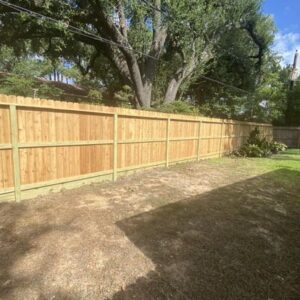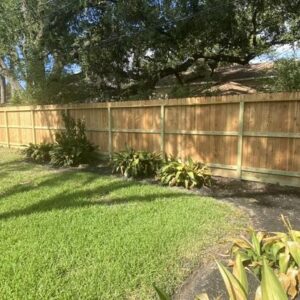 How Deep To Cement A Fence Post?
How Deep To Cement A Fence Post?
You’ve finally decided to build that fence you’ve been contemplating for months. As you stand there, shovel in hand, you can’t help but wonder: How deep should you cement the fence post?
Well, my friend, the answer is not as simple as you might think. There are several factors to consider, such as soil type, climate, and fence height.
Don’t worry, though, because in this discussion, we will explore all of these aspects and provide you with the expert advice you need from experienced custom wood fence installers in Houston to ensure a sturdy and long-lasting custom wood fence in Houston. Getting recommendations from fence professionals in your area is key to selecting high quality wood, hardware and installation methods suited to Houston’s climate to build a fence that stands up beautifully for years.
So, let’s dive right in and discover the secrets to the perfect fence post depth.
Factors Affecting Fence Post Depth
To ensure the stability of your fence, it’s crucial to consider various factors that impact the depth at which you should cement your fence posts. The post depth plays a significant role in the overall strength and durability of your fence.
When determining the appropriate depth, you must take into account the type of soil in your area, the amount of water your soil retains, and the type of concrete you plan to use.
The first factor to consider is the type of soil. Different types of soil have different load-bearing capacities. If you have clay soil, which tends to retain water, you’ll need to dig deeper to ensure proper support for your fence posts. On the other hand, sandy soil requires less depth, as it provides better drainage and stability.
Another important factor is the amount of water your soil retains. If your soil is prone to retaining water, it’s essential to dig deeper to prevent the fence posts from shifting or sinking over time. Waterlogged soil can weaken the concrete and compromise the integrity of your fence.
Lastly, the type of concrete you use will also impact the required post depth. Some concrete mixes are specifically designed for high-strength applications, while others are more suitable for standard use. The manufacturer’s instructions should provide guidance on the optimal post depth for the specific type of concrete you choose.
Recommended Depth for Cementing Fence Posts
What is the recommended depth for cementing fence posts to ensure stability and durability?
When it comes to cementing your fence posts, it’s crucial to dig deep fence post holes to achieve the desired stability. The recommended depth for cementing fence posts is typically around one-third of the total length of the post. This means that if your fence post is six feet tall, you should aim for a hole depth of at least two feet. By going this deep, you ensure that your fence post is firmly anchored into the ground, preventing it from leaning or wobbling over time.
When cementing your fence posts, it’s important to create sturdy footings similar to those used for deck posts. These footings provide additional support and help distribute the weight of the fence evenly. To achieve this, you can use concrete-sunk posts. This method involves pouring concrete into the fence post hole, creating a solid foundation for your fence.
Understanding Soil Types for Proper Post Depth
When determining the proper post depth, it’s essential to consider the different soil types in order to ensure stability and durability for your fence. Understanding the soil types will help you determine the depth at which you should cement your fence post.
First, let’s talk about clay soil. Clay soil is known for its compactness and ability to retain water. If you have clay soil, it’s important to dig your post hole deeper to ensure proper stability. A good rule of thumb is to dig the hole at least one-third the length of the post. This will provide a solid foundation and prevent the post from shifting or leaning over time.
Next, let’s discuss sandy soil. Sandy soil is loose and drains water quickly. If you have sandy soil, you’ll need to dig your post hole deeper than you’d for clay soil. A depth of at least half the length of the post is recommended to ensure stability. Additionally, you may want to consider adding some gravel at the bottom of the hole to improve drainage and prevent the post from sinking.
Lastly, let’s talk about loamy soil. Loamy soil is a mixture of clay, sand, and organic matter, making it ideal for planting. If you have loamy soil, you can follow the general guidelines mentioned earlier, digging the hole one-third to half the length of the post. However, it’s still important to assess the specific composition of your soil for better accuracy.
Considerations for Climate and Fence Height
Have you considered how climate and fence height can impact the stability and durability of your fence? When it comes to installing a fence, there are a few important factors to keep in mind.
First, let’s talk about climate. Different climates require different depths for your fence post holes. In regions with colder temperatures, it’s crucial to dig deeper holes to reach the frost line depth. This will prevent the posts from shifting or heaving as the ground freezes and thaws. On the other hand, in warmer climates, you may not need to dig as deep.
Second, the height of your fence also plays a role in its stability. Taller fences are more susceptible to strong winds, so it’s important to ensure that your posts are securely anchored. Consider using longer posts or additional supports to provide extra stability.
Additionally, the type of material used for your fence can also impact its durability in different climates. Take into account factors such as moisture levels, heat, and extreme weather conditions when choosing the right material for your fence.
Professional Vs DIY Fence Post Installation
Considering the impact of climate and fence height on the stability and durability of your fence, it’s important to weigh the pros and cons of professional versus DIY fence post installation.
Hiring a professional for fence post installation can be a smart choice if you lack the time, skills, or tools required. Professionals have the expertise to ensure that your fence posts are set at the correct depth and in the right concrete footing. They’ve access to specialized tools like post hole diggers, which can make the installation process faster and more efficient. Additionally, professionals are familiar with local building codes and regulations, ensuring that your fence is installed correctly and meets all requirements.
On the other hand, if you enjoy taking on DIY projects and have the necessary skills, installing fence posts yourself can be a rewarding experience. It allows you to have full control over the process and can save you money. However, keep in mind that DIY installation requires careful planning and attention to detail to ensure that the fence posts are set at the appropriate depth for stability.
To learn more about the longevity of fence posts and how to maximize their lifespan, check out our article on How Long Do 4X4 Fence Posts Last?
Frequently Asked Questions
How Do I Know if the Soil in My Area Requires a Deeper Fence Post Depth?
To gauge soil stability and determine if you need a deeper fence post, give it a little squeeze. If it feels loose and crumbly, go deeper. But if it’s firm and compact, you’re good to go!
Can I Use Gravel Instead of Cement to Secure My Fence Posts?
You can use gravel instead of cement to secure your fence posts. It provides adequate stability and drainage. However, consider the soil conditions in your area to ensure the posts are properly anchored.
Is There a Specific Depth Requirement for Fence Posts in Areas With Extreme Weather Conditions?
In areas with extreme weather conditions, it is important to consider a specific depth requirement for your fence posts. This ensures stability and durability against the elements. Check with local regulations or consult a professional for guidance.
What Are the Consequences of Not Properly Considering Soil Types When Determining Fence Post Depth?
Not properly considering soil types when determining fence post depth can lead to serious consequences. Your fence may not be stable, leaning or even collapsing. It’s crucial to understand your soil to ensure a secure and long-lasting fence.
Are There Any Specific Safety Guidelines to Follow When Installing Fence Posts at Greater Heights?
When installing fence posts at greater heights, it is important to follow specific safety guidelines. These guidelines ensure stability and prevent accidents. Make sure to use appropriate tools, materials, and techniques for a secure and durable fence.
Conclusion
In conclusion, the depth at which to cement a fence post depends on various factors such as soil type, climate, and fence height. It’s crucial to understand these factors to ensure the stability and longevity of the fence.
While DIY installation can save money, hiring professionals can ensure proper post depth and minimize future issues.
So, whether you choose to take on the task yourself or hire experts, make sure to consider these factors for a successful fence installation.
